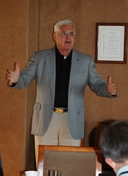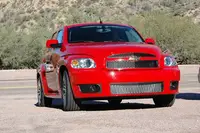2008 Chevrolet HHR SS Review
2008 CHEVY HHR SS A Retro-Modern Pocket Rocket
By Steve Purdy
TheAutoChannel.com
Detroit Bureau
 |
We gathered in the desert southwest not far from the GM Proving Grounds in Mesa, Arizona to challenge the Chevy folks to show just how hot this little car is. It is a little car, after all, sharing the versatile Delta platform with Chevy Cobalt, Pontiac G5 and Saturn Ion as well as a couple Opel products. The EPA calls it an SUV. The Europeans sanctioning the Nürburgring competition call it a compact van. I call it a retro-themed compact wagon. It really has no direct competitors, though we could say the PT Cruiser GT with turbo 4-cyliner might be close. In terms of size and performance the Chevy folks consider it in the sport compact market and compare it to the MazdaSpeed3 and Dodge Caliber SRT4. In terms of performance and handling the latter two make the most appropriate comparison, though they are very different in looks and execution.
 |
Suspension and handling were polished at the fabled Nürburgring, where the mighty fast Mr. Heinricy, a truly accomplished race driver, set the class record with the HHR SS – that class being compact vans. Perhaps that’s an unimpressive class name but the Europeans have some performance-oriented vehicles in that class. Special spring rates, damping and stabilizer bars front and rear make for an amazingly good balance between the stiffness required for competitive performance on the track and comfort required for every day driving.
Matt Purdy, GM engineer in charge of ride and handling for the HHR SS, rode with us during the first mountain road to Tortilla Flats. He described some of the challenges in meeting this balance. Most of the development work, he explained, was done stateside then the fine tuning was accomplished at the Nürburgring where the car literally goes air born four times each lap. This, by the way, is the same development regimen used for the Cadillac CTS-V and other GM performance vehicles as well as many of the most prestigious European brands.
Front suspension is conventional McPherson strut design and the rear is a semi-independent torsion bar setup. Unique steering knuckles, linear coil springs with specific damper tuning and lots of other massaging went into the effort to make the SS’s ride and handling extra competent. Another feature of this new suspension is a “tri-rated” rear springs that increase its resistance to compression as load increases. That way you can fill the car with four of your best friends and some stuff without the rear sitting down on its haunches.
Brakes are enhanced as well. While the basic HHR comes with drums in the rear, this SS comes with discs all around and larger fronts. ABS is standard. With Michelin all-weather tires they pulled 0.86g on the skid pad. That’s an admirable sports car number – better than the Corvette of a few generations ago. A Brembo front brake option will be available in a few months.
 |
That’s a lot of technology in this hot little number. Premium fuel is recommended but not required. EPA estimates fuel mileage will be about 21-city/29-highway for the stick and 19-city/28-highway for the automatic. The EPA, you’ll recall, categorizes the HHR SS as a two-wheel-drive SUV. With a 16.2-gallon tank we can expect about a 400-mile range if we don’t push too hard.
The 4-speed automatic only makes 235 horsepower and 223 pound-feet of torque – essentially the same engine just detuned a bit. This off-the-shelf GM transmission was not designed to handle more horsepower. The market for the automatic, we’re assured by the Chevy folks, is expected to be different than the market for the stick. The automatic will appeal, they think, to the enthusiast who wants better power and handling but would be unlikely to drive it competitively. At 235 horsepower, that’s still plenty for this little car - just not as awe-inspiring as 260 horsepower.
Here are a couple more tidbits of technology geared toward those who like to maximize performance but may not have the experience, or perhaps the inclination, to drive like a racer: Launch Control and No-Lift Shift – both innovations to help the less experienced performance driver have some controlled fun.
Launch Control allows the hot-shot driver of the automatic SS to get maximum traction on a start by putting his/her foot to the floor with the brake mashed, then letting off the brake allowing just the right amount of spin. I’m not convinced of that one. It seemed to me in hot-shoeing it myself that there was a bit too much wheel spin. I seem to remember from drag racing days that the ideal was just a solid, short chirp of wheel spin, then bite. This may have something to do with tire technology as well. Certainly, drag slicks would make for different dynamics.
No-Lift Shift is cool, too. From a dead start, with the stick transmission car, just goose it to about 4-grand. Get off the clutch quickly (don’t dump it), then keep your foot to the floor as you clutch to upshift to 2nd and 3rd. The system will automatically keep the rpms at about 4-grand so the turbo won’t have to spool up again between shifts - great for the track or strip. They Chevy folks list a zero-to-60 time of 6.3 seconds and a quarter-mile time of 14.8 seconds at 98.5 mph.
 |
SS’s sport steering wheel is a tad smaller and fatter than the base HHR’s, and feels great. A pilar-mounted boost gauge and 140-mph speedometer let us know we’re in something special. Top speed for the automatic is 130-mph and about 155 for the stick.
So what about practicality? This 3,200-pound screamer is easy to enter and exit, has good visibility and 25.2 cubic-feet of cargo space behind the second seat – 63.1 with the seat down. Trailering is “not recommended.”
 |
Now, for the fun part. The track was gated to guide us through a fast line around the track. It didn’t take very many laps before I knew where we could get on it hard and where we had to delicately dance through the tighter turns. The electric power steering felt precise and under complete control. A couple of full-power “yumps” allowed it to get just a tad squirrely with most of the weight off the ground – still an admirable performance. Just when I was beginning to think I was quite a hot-shoe in getting around the track I took a demonstration with Mr. Heinricy behind the wheel. He really made the SS dance and fly. Amazing!
 |
One final detail I’m impressed with: the hood hold’s itself up with two delicate-looking struts. You’d be surprised how many expensive cars have prop rods.
Prices start at $22,995 for the 5-speed stick, including the $650 destination charge and $1,000 more for the automatic with remote start. Though the HHR SS is reaching dealers now (first quarter of ’07), you might have a hard time getting one early on, so better get in line.
© Steve Purdy, Shunpiker Productions, All Rights Reserved



